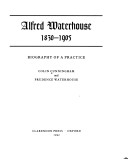Clarendon Studies in the History of Art S.
1 primary work
Book 9
Alfred Waterhouse was one of the most successful British architects of the second half of the 19th century. Following the passion for Gothic espoused by Pugin and Ruskin he developed his own highly individual "modern" Gothic, but could turn his hand to other styles with equal confidence. He accepted up-to-date methods of building and revelled in modern materials such as terracotta. His efficient office appealed to businessmen and institutions for whom he built extensively but he was also an accomplished artist of the picturesque. An architect of wide ability he has left a handful of major buildings of rare genius such as the Natural History Museum and Manchester Town Hall. He has also left his mark on towns and cities all over Britain with schools, colleges, hospitals, banks and offices as well as a selection of churches and almost 90 houses. This book details Waterhouse's long and successful career and demonstrates his importance for all those with an interest in the 19th century.
